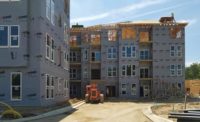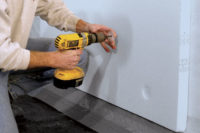Choosing the Right Materials
Choosing the most economically and environmentally appropriate gypsum products and “building from the inside out” reduces the likelihood of costly construction delays and remediation.


A mighty Alaskan Muskox is witness to the progress of the new Norton Sound Regional Hospital in Nome Alaska, part of the Alaska Native Tribal Health Consortium. The new hospital construction features DensGlass Sheathing from G-P Gypsum, covered with Henry BlueSkin Air Barrier System. Photo by Cal Myrick, Neeser Construction.






Contractors and building owners must remain vigilant in pursuing the best and most efficient methods for completing projects on time and within budget—in good economic times or bad.
Building owners are eager to open the doors of new or remodeled commercial structures so the revenue stream can begin to flow from rent-paying tenants. To get owners to that point, contractors are mindful of tactics that will keep them on schedule while still generating acceptable profit margins. Plus, their choices must mitigate the possibility of down-the-road expenses should any component fail or become damaged.
Ultimately, this means using all resources at their disposal to make sure the right materials are used in the right places at the right time.
Fortunately, the industry has never before had such a wealth of options to address each of the criteria mentioned, giving contractors and owners the ability to select specialized materials that easily fit within a building assembly or envelope.
This is especially true with wall and ceiling gypsum boards, which offer varying degrees of strength, durability, flexibility, mold and moisture resistance, sustainability and scheduling benefits that contractors should assess when selecting materials.
Fiberglass Mat Gypsum Boards Perfect for “Pre-Rock”
With respect to project timetables, construction delays and higher expenses due to adverse weather conditions must be avoided if possible. So using materials with moisture- and mold-resistant properties “pre-rock” (when board is hung to provide fire protection and enclose ducts, chase areas and the like) means boards can be hung before windows and exterior doors are installed and the roof is complete.
Selecting gypsum boards with fiberglass mats for areas that are unsheltered during this phase of construction can keep crews working through the humid, rainy or wintery seasons—reaping significant scheduling, financial, and risk reduction benefits. These boards are useful for exterior and interior surfaces of the building enclosure, in mechanical areas, in elevator shafts and stairwells.
Fiberglass mat-faced gypsum boards provide unsurpassed moisture and mold resistance for new construction and renovations. As a result, interior and exterior crews can work simultaneously even if the weather is uncooperative, without negatively impacting the quality, safety or sustainability of the project.
Billions of square feet of fiberglass-mat gypsum panels have been installed over the last 25 years, proving their performance value in time-sensitive construction projects. To substantiate that, Georgia-Pacific Gypsum and a division of Turner Construction executed a simulation-based study that quantifies the scheduling benefits of certain building materials.
Results revealed that fiberglass mat-based gypsum panels could be installed earlier in the process, which accelerated the construction schedule by up to 10 weeks for a specific project. This delivers significant cost savings for the contractor, and hastens the opening of the facility and arrival of rent-paying tenants.
More importantly, they also have the durability to maintain their mold- and moisture-resistant properties after construction has finished. Few, if any, panels need to be replaced during or after construction if exposed to weather conditions or during the operation of the building due to unplanned water intrusion or leaks.
By reducing tear-outs due to water damage, fiberglass mat gypsum panels help ensure the long-term sustainability of a building and can have a positive impact on indoor air quality. This is especially important since segments such as healthcare and schools pay much attention to indoor air quality.
Fiberglass-mat gypsum panels’ attributes are also critical in areas where flooding is a danger, as they resist the effects of surface water exposure after the construction cycle, and thus provide resistance to potential mold growth. Check the Federal Emergency Management Association guidelines for wall and ceiling applications in Special Flood Hazard Areas (SFHAs). (Document is titled TB-2/2008 Flood Damage –Resistant Materials Requirements. Download the FEMA file at http://bit.ly/IX9FA8.) for details.
Economical Options for Areas with Reduced Moisture Intrusion Risk
For areas of the building that have a reduced moisture intrusion risk during construction and occupancy, contractors may prefer paper-faced gypsum panels. Doing so can further the economic efficiency of the project but only if the boards have high levels of moisture intrusion protection.
For instance, ToughRock Mold-Guard is a good choice for kitchens, laundry rooms and non-wet areas of bathrooms, as well as any areas where wallboard is to be hung after the windows and doors are installed, the roof and cladding are sealed and the area is conditioned.
In summary, choosing the most economically and environmentally appropriate gypsum products and “building from the inside out” reduces the likelihood of costly construction delays and remediation. Shorter schedules may mean lower contractor costs and potential accelerated revenues for building owners and in these tough economic times, that’s a good formula for success. W&C
Looking for a reprint of this article?
From high-res PDFs to custom plaques, order your copy today!












